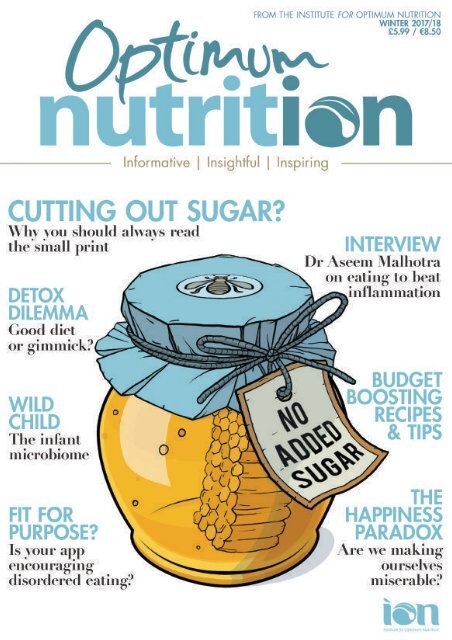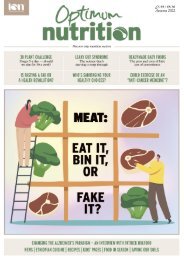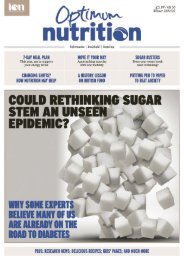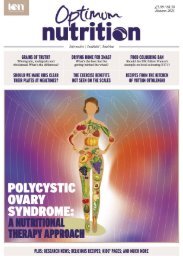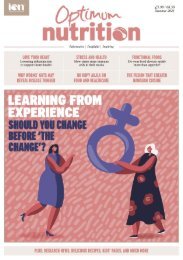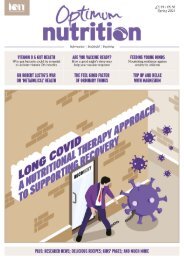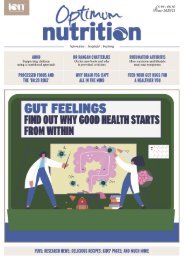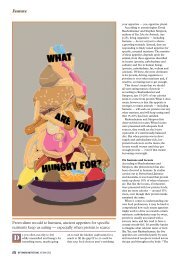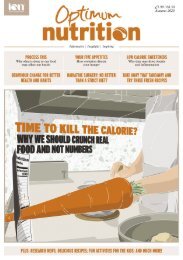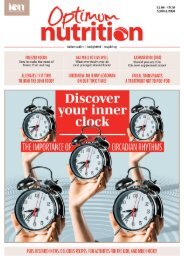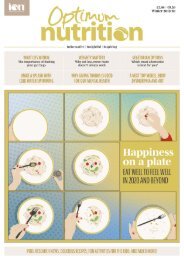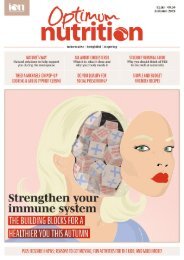Create successful ePaper yourself
Turn your PDF publications into a flip-book with our unique Google optimized e-Paper software.
NUTRITIONAL THERAPY FOR ALL<br />
<strong>Nutrition</strong>al therapy is a science-based practice which seeks to address the root cause of your<br />
health concerns, not just the symptoms.<br />
Through tailored food, nutrient and lifestyle recommendations to suit your individual needs,<br />
it aims to help you towards maintaining optimum health and improved well-being.<br />
LEARN IT EXPERIENCE IT SHARE IT<br />
NUTRITIONAL<br />
THERAPY DIPLOMA<br />
1 AND 3 DAY<br />
SHORT COURSES<br />
OPTIMUM NUTRITION<br />
MAGAZINE<br />
SCIENCE ACCESS<br />
COURSE<br />
OPTIMUM NUTRITION<br />
CLINIC<br />
OPTIMUM NUTRITION<br />
LITE BITES<br />
www.ion.ac.uk | info@ion.ac.uk | @ion_nutrition | instituteforoptimumnutrition | 020 8614 7800
THIS ISSUE<br />
CONTENTS<br />
8 14 20<br />
DETOX OR NOT?<br />
It is tempting to try a detox, but<br />
do we really need to and, if so, do<br />
we need expensive products to do<br />
it successfully? We ask qualified<br />
nutritional therapists their views<br />
and what approach, if any, they<br />
take in clinical practice<br />
WASTE NOT, WANT NOT<br />
January can be a long month after<br />
all the festive holidays. If you are<br />
tightening the purse strings, it may<br />
be time to think before binning<br />
those leftovers and kitchen scraps.<br />
Our team shares budget-boosting<br />
tips to help reduce waste<br />
INTERVIEW<br />
Dr Aseem Malhotra, outspoken<br />
health campaigner, cardiologist,<br />
and author, talks to Louise Wates<br />
about his take on the popular<br />
Mediterranean diet and why he<br />
thinks public health policy needs<br />
to be held to account<br />
REGULARS<br />
<strong>18</strong> FEATURE<br />
Before you throw that unwanted,<br />
unopened Christmas pudding into the bin,<br />
read what Alice Ball discovered on a day’s<br />
visit to her local food bank<br />
24 ON YOUR PLATE<br />
32 WORLD CUISINE<br />
When Kei Lum Chan and his wife tried<br />
to capture the tastes of China, they were<br />
taking on an enormous but delicious task.<br />
They share their favourite recipes with us<br />
34 DIFFERENT STROKES<br />
42 CASE STUDY<br />
Nicola Moore from The <strong>Optimum</strong><br />
<strong>Nutrition</strong> Clinic looks at supporting Helen,<br />
who, since having children, would like to<br />
lose a little weight and gain a lot of energy<br />
44 LITTLE LIVES<br />
We share four easy recipes from The<br />
Flexible Vegetarian by Jo Pratt, a tempting<br />
new cookbook with nutritious, tasty, and<br />
inexpensive supper suggestions<br />
By searching for what will make us happy,<br />
are we only making ourselves sad? In<br />
preparation for World Happiness Day,<br />
Ellie Smith ponders the paradox<br />
Does your little one need to be a wild<br />
child? Catherine Morgan looks at recent<br />
research into the infant microbiome and<br />
the benefits of outside play<br />
29 FOOD FACT FILE<br />
36 ALL ABOUT<br />
48 MOVE IT<br />
As sugar’s reputation takes a nosedive,<br />
we look at why, if you are trying to reduce<br />
your sugar intake, you need to check the<br />
labels to know what you are really eating<br />
If you want to cut down on animal<br />
products but don’t want to become<br />
vegetarian or vegan, consider the<br />
reducetarian way. Celia Jarvis writes<br />
Fitness apps are a great way to keep an<br />
eye on how much exercise we do (or don’t<br />
do). Amelia Glean looks at the pros and<br />
cons of this technological revolution<br />
04 COMMENT / NEWS 28 KITCHEN CHEMISTRY<br />
40 PRODUCT NEWS<br />
12 RESEARCH UPDATE 39 BOOK THERAPY<br />
47 IN SEASON<br />
WINTER <strong>2017</strong>/<strong>18</strong> | OPTIMUM NUTRITION<br />
3
FEATURE<br />
Once the last New Year firework has crackled and spluttered,<br />
January can suddenly seem very bleak — particularly when it is<br />
a long time until the next pay day. However, after the season of<br />
extravagence, getting the most out of our food budget not only<br />
makes sense for our wallets, but for the environment too<br />
Every year the average UK family<br />
throws away an estimated £700 of<br />
food. According to the Food and<br />
Agriculture Organization of the United<br />
Nations (FAO) around a third of all the<br />
food produced in the world (about 1.3<br />
billion tonnes) gets lost or wasted — to<br />
the value of around US$680 billion in<br />
industrialised countries and US$310<br />
billion in developing countries.<br />
Anyone who remembers news<br />
reports of butter mountains and milk<br />
lakes knows that the problem of food<br />
waste is not new. On a domestic front,<br />
it used to be common practice for<br />
supermarkets to pour detergents over<br />
thrown away, unsold food to deter any<br />
hungry homeless scavengers. In more<br />
recent years, however, there has been<br />
an effort to make the most out of waste.<br />
Many supermarkets and cafés now send<br />
their end-of-date stock to foodbanks and<br />
community kitchens: a spokesperson for<br />
Sainsbury’s told <strong>Optimum</strong> <strong>Nutrition</strong> that<br />
none of its food waste goes to landfill and<br />
is either donated to food banks, recycled<br />
into animal feed, or converted to biofuel<br />
via anaerobic digestion.<br />
However, “bakery products can’t be<br />
donated to food banks as, due to the area<br />
in which they were created, they carry a<br />
risk of allergen cross contamination so we<br />
can’t guarantee they would be suitable<br />
for allergen sufferers. But they will still be<br />
recycled or converted”.<br />
Although many of us won’t have an<br />
eye on the bigger environmental picture,<br />
reducing the amount of food waste we<br />
produce could shave pounds off the<br />
weekly budget. It might seem a lot of<br />
effort just to save some pence here and<br />
there, but putting into action the — dare<br />
we say it — old expression ‘take care<br />
of the pennies and the pounds will look<br />
after themselves’, can be challenging and<br />
rewarding. So here are some tips on how<br />
to uninvite your kitchen bin to dinner.<br />
Know your dates<br />
‘Use by’ and ‘best before’ dates can be<br />
confusing, but the important one is ‘use<br />
by’ — food cannot be sold after this<br />
date. On its website, the Food Standards<br />
Agency (FSA) states: “Use by date is<br />
about safety… Foods can be eaten (and<br />
most can be frozen) up until the use by<br />
date, but not after. You will see use by<br />
dates on food that goes off quickly, such<br />
as meat products or ready-prepared<br />
salads. For the use by to be a valid<br />
guide, you must carefully follow storage<br />
instructions.”<br />
‘Best before’ is not an indicator of<br />
safety. Food is considered edible after<br />
this date, but may have lost some of its<br />
quality; a common example is spices,<br />
which many of us may have lurking at<br />
the back of the cupboard long after the<br />
best before date has passed into distant<br />
memory. The FSA does state, however,<br />
that: “The best before date will only be<br />
accurate if the food is stored according<br />
to the instructions on the label.” So, the<br />
bottom line is: don’t throw foods away if<br />
they are past their best before date and<br />
have been stored correctly.<br />
If you want to think about how your<br />
actions impact food waste on a wider<br />
scale, try working with sell by dates.<br />
Shops have to operate within the law<br />
when it comes to sell by dates, and we can<br />
help by working with the supermarkets.<br />
This includes being willing to buy reduced<br />
items and just-in-date food with a bigger<br />
picture mindset. Or if you tend to search<br />
shelves for the longest expiry date,<br />
consider choosing food that has less time<br />
on it, with plans to eat it that night. Yes,<br />
it may be marginally older, but it’s all safe<br />
and okay to eat.<br />
Little and often<br />
If soggy vegetables are regularly found<br />
composting at the bottom of your fridge,<br />
it could be time to change how you<br />
14 OPTIMUM NUTRITION | WINTER <strong>2017</strong>/<strong>18</strong>
FEATURE<br />
shop, such as buying small amounts of<br />
fresh produce when you need it. Bulkbuying<br />
may be easy, time-saving, and<br />
cost-effective, but if your purchases<br />
end up rotting away, they are a false<br />
economy. Using the new smaller ‘express’<br />
supermarkets is one way of buying what<br />
we need when we need it, and avoiding<br />
the temptation of large supermarket aisles<br />
that are designed to lure us in to buy<br />
more. If you need to buy food on a daily<br />
basis, write a list — and stick to it!<br />
Plan ahead<br />
If you are shopping for the week, make<br />
a list, and if you get drawn into buying<br />
additional items on offer (such as meat<br />
products), freeze the extras on the day of<br />
purchase rather than thinking you will use<br />
them that week.<br />
Checking your diary can also help<br />
reduce food waste — if you are going to<br />
be out or away, do you need fresh produce<br />
at home? If not, frozen produce might be a<br />
better option. Because of farm-to-freezer<br />
times, frozen produce is a good source of<br />
nutrition, and will keep for when you need<br />
it. It can be cheaper, too. For example,<br />
if you like fruit with your porridge or in<br />
a smoothie, frozen mixed berries help<br />
provide a varied diet without committing<br />
to buying a pack of each type — and often<br />
cost less than buying fresh.<br />
#FoodPrepSunday<br />
Cook once to eat twice — or more. Batch<br />
cooking has many benefits that outweigh<br />
the initial outlay of time that it takes. The<br />
more you prepare, the more time you get<br />
back through the absence of daily cooking<br />
and making decisions on what to eat or<br />
buy. You also know exactly what you’re<br />
eating. By spending a couple of hours<br />
batch cooking more than one kind of dish,<br />
you can get variety into your diet, too.<br />
When cooking and freezing, divide the<br />
ingredients between two pots and use<br />
different seasonings to make something<br />
different: e.g. a large batch of lentils can<br />
be used to make vegetarian bolognaise<br />
in one pot and spicy daal in the other;<br />
chickpeas can be divided to make a stew<br />
and falafel; or use different herbs and<br />
spices to turn minced meat into curry in<br />
one pot and the base for a cottage pie in<br />
the other (add frozen mash as needed).<br />
Freeze it<br />
Using the freezer is fundamental to<br />
reducing food waste. For example, freeze<br />
half your loaf of bread and use the frozen<br />
half for toast straight from frozen, and<br />
the fresh half for sandwiches. Freeze in<br />
accordance with your eating habits. Eat<br />
more toast? Freeze 70 per cent of the<br />
loaf. (Although bread can be frozen and<br />
defrosted as needed — you just have<br />
to plan if you want a sandwich!) Some<br />
foods (e.g. cheese) may change slightly in<br />
texture but are perfectly edible.<br />
If you have had fresh veg in the fridge<br />
for a couple of days and don’t anticipate<br />
using it soon, clean it, cut it up (if<br />
necessary) and freeze it. Mushrooms<br />
can be sliced and frozen, even tomatoes<br />
that look too elderly for salads can be<br />
frozen to be used in a soup or stew. Fresh<br />
vegetables may not have the greatest<br />
texture after being frozen, but are usually<br />
good for the stew pot. Even leftover<br />
boiled potatoes and sweet potatoes can<br />
be frozen — once defrosted they will<br />
lose some of their water content and<br />
look a little sad, but they can be sliced<br />
and fried (lashings of oil not required!).<br />
Alternatively, they can be mashed before<br />
being frozen. Freeze bananas to make<br />
banana pancakes, banana bread and<br />
banana ‘ice cream’. Bananas can be frozen<br />
in their skins but will need to at least<br />
partially defrost before being used (the<br />
banana can be removed by squeezing one<br />
end, and then the banana will usually plop<br />
out!); but it’s much more convenient to<br />
peel and slice them before freezing!<br />
Portion it<br />
If it’s your habit to defrost a packet of<br />
sausages just to use a couple and then<br />
leave the rest to go bad, take time to<br />
portion foods into wrappers or containers<br />
before freezing them. A general rule of<br />
thumb is, if it can be frozen then it can<br />
be portioned up first. Use containers,<br />
wrapping or bags to portion up cheeses,<br />
meat such as bacon, chops, mince and<br />
poultry, and other staples such as milk<br />
and bread.<br />
Get creative<br />
Don’t be afraid to experiment and keep<br />
a supply of herbs and spices to jazz up<br />
your meals. Fresh herbs are very versatile:<br />
they can be washed and frozen as they<br />
are, creatively turned into butter cubes<br />
(using an ice cube tray) to be defrosted<br />
when needed for meat and fish dishes, or<br />
added straight from the freezer to use in<br />
cocktails. Spices such as chillies, peeled<br />
ginger, and garlic can all be used straight<br />
from the freezer.<br />
Know what you have<br />
Don’t ignore mouldy veg at the bottom of<br />
your fridge because the mould will spread!<br />
Rummage at the back of cupboards, and<br />
the fridge and freezer to see what you<br />
already have. Check dates and if you<br />
know you won’t eat something in time,<br />
freeze it. If you’re a technophile, maybe<br />
WINTER <strong>2017</strong>/<strong>18</strong> | OPTIMUM NUTRITION<br />
15
ON YOUR PLATE<br />
We looked for inexpensive, simple,<br />
and warming dishes to keep us<br />
satisfied this winter, and think that<br />
these recipes from The Flexible<br />
Vegetarian by Jo Pratt fit the bill!<br />
Loaded with delicious ideas, Jo’s<br />
book offers solutions to keep both<br />
vegetarians and meat-eaters happy<br />
Published by Frances Lincoln (£20)<br />
Photography by Susan Bell<br />
ISBN: 978-0711239043<br />
Jo says: “This is a contender for my favourite<br />
recipe in the book — just looking at it makes<br />
me want to polish off the whole bowl. It’s<br />
mellow and cheesy and so lovely eaten on<br />
its own, but the meltingly soft, sticky, sweet<br />
roast onions piled in the middle really make it<br />
something super special. It’s very difficult to<br />
stop at just one bowl, which is why I’ve made<br />
the recipe big enough for eight portions.”<br />
TIME TAKEN 1 HOUR / SERVES 8<br />
INGREDIENTS<br />
• 50 g/2 oz butter<br />
• 1 onion, chopped<br />
• 2 cloves garlic, peeled and roughly<br />
chopped<br />
• 1 bay leaf<br />
• 1 large cauliflower, broken into small<br />
florets (you need about 800 g/1 lb 12<br />
oz florets)<br />
• 1 baking potato, peeled and chopped<br />
• 500 ml/17 fl oz/2 cups milk<br />
• 750 ml/26 fl oz/3 cups vegetable<br />
stock<br />
• 300 g/10½ oz cream cheese<br />
• 1 tsp English mustard<br />
• Flaked sea salt and freshly ground<br />
black pepper<br />
• 1 tbsp nigella seeds, to serve<br />
For the onions<br />
• 4 large onions, peeled and each cut<br />
into 8<br />
• 3 tbsp olive oil, plus extra for serving<br />
• 50 g/2 oz butter<br />
• Handful thyme sprigs<br />
METHOD<br />
Heat the oven to 200C/400F/gas 6. Put the<br />
onion wedges in a large roasting tray. Trickle<br />
over the oil, dot with butter and scatter<br />
around the thyme sprigs. Bake in the oven for<br />
30–45 minutes until the onions are golden<br />
and sticky, turning and basting in the butter a<br />
few times.<br />
To make the soup, melt the butter in a large<br />
saucepan. Add the onion and cook until it is<br />
softened but not coloured.<br />
Stir in the garlic, bay leaf, cauliflower and<br />
potato. Reduce the heat, cover with a lid<br />
and leave to cook for 15 minutes, stirring<br />
occasionally. Make sure the vegetables don’t<br />
brown, and if they are sticking add a splash<br />
of water to the pan. Remove the lid and pour<br />
in the milk and the stock. Simmer for 15<br />
minutes, or until the cauliflower and potato<br />
are tender and beginning to break up.<br />
Put the cream cheese in a bowl with the<br />
mustard and beat with a wooden spoon<br />
to give you a whipped cream consistency.<br />
Remove the soup from the heat and take out<br />
the bay leaf. Stir in around two thirds of the<br />
cream cheese and mustard.<br />
Cool slightly and then blitz in a food<br />
processor or blender until velvety smooth.<br />
You’ll probably have to do this in two batches.<br />
Season to taste with salt and freshly ground<br />
black pepper.<br />
Serve the soup hot with a dollop of the<br />
whipped cream cheese, some sweet sticky<br />
onions piled in the middle, a sprinkle of nigella<br />
seeds and a drizzle of olive oil.<br />
Flexible<br />
“Add 75 g/2½ oz diced pancetta to the<br />
onions halfway through their cooking time<br />
and serve both on top of the finished soup.”<br />
24 OPTIMUM NUTRITION | WINTER <strong>2017</strong>/<strong>18</strong>
ON YOUR PLATE<br />
Jo says: “A colourful dish that will wake<br />
up your taste buds. The mushrooms and<br />
tomatoes are roasted until juicy and tender —<br />
it’s the corncakes that give the big hit of spice.<br />
Turmeric, ginger, cumin, fresh coriander and<br />
spring onion are all combined with crumbly<br />
paneer cheese and sweetcorn to make these<br />
corncakes the star of the show.”<br />
TIME TAKEN 30 MIN / SERVES 4<br />
INGREDIENTS<br />
• 4 large flat or portobello mushrooms<br />
• 4 ripe tomatoes, halved<br />
• Olive oil<br />
• 225 g/8 oz paneer cheese, grated<br />
• 150 g/5 oz sweetcorn<br />
• 4 tbsp plain (all purpose) flour<br />
• 2 spring onions (scallions), finely<br />
chopped<br />
• 1 cm/½ inch piece ginger, peeled and<br />
grated<br />
• 2 tsp ground turmeric<br />
• ½ tsp ground cumin<br />
• Small bunch coriander (cilantro),<br />
roughly chopped<br />
• 6 eggs<br />
• 2 tbsp white wine or malt vinegar<br />
• Flaked sea salt and freshly ground black<br />
pepper<br />
METHOD<br />
Heat the oven to 200C/400F/gas 6. Sit<br />
the mushrooms and tomato halves in a<br />
roasting tray.<br />
Drizzle fairly generously with olive oil and<br />
season with salt and pepper. Put in the oven<br />
to roast for around 20 minutes until the<br />
mushrooms are golden and tender, turning<br />
the mushrooms over halfway through.<br />
Put the grated paneer, sweetcorn, flour,<br />
spring onions, ginger, turmeric, cumin,<br />
coriander, 1 tsp of salt, and a really generous<br />
twist of black pepper in a bowl. Lightly beat<br />
together two of the eggs and add to the<br />
bowl. Mix everything together really well.<br />
Using wet hands, divide the mixture into<br />
four and shape into thick round cakes.<br />
Heat a medium–large frying pan over a<br />
medium heat with enough olive oil to coat<br />
the base. Add the corn cakes, and cook for<br />
around 3 minutes each side, until golden and<br />
firm.<br />
While the corncakes are cooking, bring a<br />
pan of water to a simmer.<br />
Add the vinegar, then break in the<br />
remaining four eggs. Simmer for 3 minutes<br />
to poach the eggs.<br />
Place the corncakes on plates, top with<br />
a roasted mushroom, tomatoes, and finish<br />
with a poached egg each. Add a twist of<br />
pepper and a pinch of salt, and enjoy.<br />
Flexible<br />
“There are a few ways you can be flexible<br />
with this recipe. Firstly, you can turn this into<br />
even more of an Anglo-Indian brunch by<br />
serving fried bacon or sausages on the side.<br />
You could also fry some sliced black<br />
pudding to serve with the corncakes. Or<br />
to make the corncakes themselves a bit<br />
different, add 75 g/2½ oz of thinly-sliced<br />
ham or pastrami into the mix before shaping<br />
and cooking.”<br />
<strong>Optimum</strong> <strong>Nutrition</strong> tip: If you are not used to the<br />
taste of turmeric you may find it a bit bitter, so try<br />
using 1/4 tsp the first time you make this.<br />
WINTER <strong>2017</strong>/<strong>18</strong> | OPTIMUM NUTRITION<br />
25
DIFFERENT STROKES<br />
Tuesday 20 March is International Day of Happiness when we are encouraged to make the<br />
world a happier place. So, how will you be celebrating? asks Ellie Smith<br />
So will you be leaping out of bed with<br />
a spring in your step and a smile on<br />
your face, blasting out the Pharrell<br />
Williams hit Happy while skipping into<br />
work? Possibly not. For most of us, it’s<br />
more likely it’ll be a pretty average March<br />
Tuesday; but with all the talk about ways<br />
to enhance our happiness, it’s easy to feel<br />
bad about not feeling happy.<br />
As a society, we seem to be obsessed<br />
with happiness — more than ever before.<br />
A quick Google search for the word<br />
yields millions of results, and there are<br />
thousands of books about the topic for<br />
sale on Amazon. Mo Gawdat, Google’s<br />
chief business officer, recently created<br />
the first equation for happiness, which<br />
requires balancing experiences and<br />
expectations, and his Channel 4 interview<br />
discussing it became the channel’s most<br />
downloaded video ever.<br />
But what is happiness? The Dalai<br />
Lama, who has spent a lifetime pondering<br />
happiness and suffering, defines it thus:<br />
34 OPTIMUM NUTRITION | WINTER <strong>2017</strong>/<strong>18</strong>


